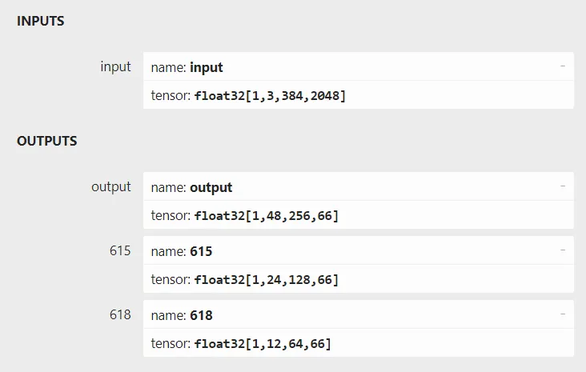01 技术背景
YOLOv5 是一种高效的目标检测算法,尤其在实时目标检测任务中表现突出。YOLOv5 通过三种不同尺度的检测头分别处理大、中、小物体;检测头共包括三个关键任务:边界框回归、类别预测、置信度预测;每个检测头都会逐像素地使用三个 Anchor,以帮助算法更准确地预测物体边界。
YOLOv5 具有多种不同大小的模型(YOLOv5n、YOLOv5s、YOLOv5m、YOLOv5l、YOLOv5x)以适配不同的任务类型和硬件平台。本文以基于色选机数据集训练出的 YOLOv5n 模型为例,介绍如何使用 PTQ 进行量化编译并使用 C++进行全流程的板端部署。
02 模型输入输出说明
本示例使用的 Yolov5n 模型,相较于公版在输入和输出上存在以下 2 点变动:
1、输入分辨率设定为 384x2048,从而输出分辨率也调整为了 48x256,24x128,12x64
2、类别数量设定为 17,因此输出 tensor 的通道数变为了(17+4+1)x3=66
从 pytorch 导出的 onnx 模型,具体的输入输出信息如下图所示:
同时,为了优化整体耗时,模型尾部的 sigmoid 计算被放在了后处理。
03 工具链环境
horizon-nn 1.1.0 horizon_tc_ui 1.24.3 hbdk 3.49.15
复制代码
04 PTQ 量化编译流程
4.1 准备校准数据
先准备 100 张如上图所示的色选机数据集图片存放在 seed100 文件夹,之后可借助 horizon_model_convert_sample 的 02_preprocess.sh 脚本帮助我们生成校准数据。
02_preprocess.sh
python3 ../../../data_preprocess.py \ --src_dir ./seed100 \ --dst_dir ./calibration_data_rgb_f32 \ --pic_ext .rgb \ --read_mode opencv \ --saved_data_type float32
复制代码
preprocess.py
def calibration_transformers(): transformers = [ PadResizeTransformer(target_size=(384, 2048)), HWC2CHWTransformer(), BGR2RGBTransformer(data_format="CHW"), ] return transformers
复制代码
校准数据仅需 resize 成符合模型输入的尺寸,并处理成 chw 和 rgb 即可。也就是说,除了归一化,其他操作都要对齐浮点模型训练时的数据预处理,而归一化可以放到模型的预处理节点中实现加速计算。
4.2 配置 yaml 文件
model_parameters: onnx_model: 'yolov5n.onnx' march: 'bayes-e' working_dir: 'model_output' output_model_file_prefix: 'yolov5n'input_parameters: input_type_rt: 'nv12' input_type_train: 'rgb' input_layout_train: 'NCHW' norm_type: 'data_scale' scale_value: 0.003921568627451calibration_parameters: cal_data_dir: './calibration_data_rgb_f32' cal_data_type: 'float32' calibration_type: 'default'compiler_parameters: optimize_level: 'O3'
复制代码
input_type_rt 指模型在部署时输入的数据类型,考虑到视频通路传来的通常都是 nv12,因此我们将该项置为 nv12。
input_type_train 指浮点模型训练时使用的数据类型,这里使用 rgb。
input_layout_train 指浮点模型训练时使用的数据排布,这里使用 NCHW。
norm_type 和 scale_value 根据浮点模型训练时使用的归一化参数设置,这里配置 scale 为 1/255。
这样配置后,上板模型会自带一个预处理节点,用来将 nv12 数据转换为 rgb 并做归一化,这个预处理节点可以被等效转换为卷积,从而支持 BPU 加速计算,进而显著减少预处理耗时。
我们强烈建议您在编译处理图像任务的模型时,使用这种配置方法。上板模型的数据输入类型可直接使用 nv12,同时我们也提供了板端读取 bgr 图片并转换为 nv12 格式的 C++代码供您参考。
4.3 编译上板模型
hb_mapper makertbin --config ./yolov5n_config.yaml --model-type onnx
复制代码
执行以上命令后,即可编译出用于板端部署的 bin 模型。
=============================================================================Output Cosine Similarity L1 Distance L2 Distance Chebyshev Distance -----------------------------------------------------------------------------output 0.996914 0.234755 0.000420 5.957216 613 0.997750 0.232995 0.000744 8.833645 615 0.995946 0.281512 0.001877 4.717240
复制代码
根据编译日志可看出,yolov5n 模型的三个输出头,量化前后的余弦相似度均>0.99,符合精度要求。
4.4 onnx 和 bin 的一致性验证(可选流程)
PTQ 量化流程会生成 yolov5n_quantized_model.onnx 和 yolov5n.bin,前者是量化后的 onnx 模型,后者是上板模型。通常来说,这两个模型具有完全相同的精度,可以使用这种方法进行验证。
yolov5n_quantized_model.onnx
import cv2 import numpy as np from PIL import Image from horizon_tc_ui import HB_ONNXRuntime
def bgr2nv12(image): image = image.astype(np.uint8) height, width = image.shape[0], image.shape[1] yuv420p = cv2.cvtColor(image, cv2.COLOR_BGR2YUV_I420).reshape((height * width * 3 // 2, )) y = yuv420p[:height * width] uv_planar = yuv420p[height * width:].reshape((2, height * width // 4)) uv_packed = uv_planar.transpose((1, 0)).reshape((height * width // 2, )) nv12 = np.zeros_like(yuv420p) nv12[:height * width] = y nv12[height * width:] = uv_packed return nv12 def nv12Toyuv444(nv12, target_size): height = target_size[0] width = target_size[1] nv12_data = nv12.flatten() yuv444 = np.empty([height, width, 3], dtype=np.uint8) yuv444[:, :, 0] = nv12_data[:width * height].reshape(height, width) u = nv12_data[width * height::2].reshape(height // 2, width // 2) yuv444[:, :, 1] = Image.fromarray(u).resize((width, height),resample=0) v = nv12_data[width * height + 1::2].reshape(height // 2, width // 2) yuv444[:, :, 2] = Image.fromarray(v).resize((width, height),resample=0) return yuv444
def preprocess(input_name): bgr_input = cv2.imread("seed.jpg") nv12_input = bgr2nv12(bgr_input) nv12_input.tofile("seed_nv12.bin") yuv444 = nv12Toyuv444(nv12_input, (384,2048)) yuv444 = yuv444[np.newaxis,:,:,:] yuv444_128 = (yuv444-128).astype(np.int8) return yuv444_128
def main(): sess = HB_ONNXRuntime(model_file="./yolov5n_quantized_model.onnx") input_names = [input.name for input in sess.get_inputs()] output_names = [output.name for output in sess.get_outputs()] feed_dict = dict() for input_name in input_names: feed_dict[input_name] = preprocess(input_name) output = sess.run(output_names, feed_dict) print(output[0][0][0][0]) if __name__ == '__main__': main()
复制代码
在读取原始图像后,将其转换为 nv12 格式并保存,之后处理成 yuv444_128 格式并送给模型推理。
由 print(output[0][0][0][0])打印出的信息如下:
[ 0.18080421 0.4917729 0.34173843 0.26877916 -10.983349 -3.8538744 -1.8031031 -2.2803051 -1.5579813 -1.8910917 -3.7208636 -2.4970834 -2.8638227 -3.5894732 -3.338331......
复制代码
yolov5n.bin
hrt_model_exec infer --model-file yolov5n.bin --input-file seed_nv12.bin --enable_dump true --dump_format txt
复制代码
这里我们将上一步保存的 nv12 数据作为 bin 模型的输入,并保存输出数据,其中第一个输出分支的数据如下:
0.180804208 0.491772890 0.341738433 0.268779159 -10.983348846 -3.853874445 -1.803103089 -2.280305147 -1.557981253 -1.891091704 -3.720863581 -2.497083426 -2.863822699 -3.589473248 -3.338330984 ......
复制代码
可以看到,yolov5n_quantized_model.onnx 和 yolov5n.bin 具有相同的输出。
05 Runtime 部署流程
在算法工具链的交付包中,ai benchmark 示例包含了读图、前处理、推理、后处理等完整流程的 C++源码,但考虑到 ai benchmark 代码耦合度较高,有不低的学习成本,不方便用户嵌入到自己的工程应用中,因此我们提供了基于 horizon_runtime_sample 示例修改的简易版本 C++代码,只包含 1 个头文件和 1 个 C++源码,用户仅需替换原有的 00_quick_start 示例即可编译运行。
该 C++ demo 包含对单帧数据的读图(bgr->nv12),模型推理(包含预处理),后处理,打印输出结果等步骤。
5.1 头文件
该头文件内容主要来自于 ai benchmark 的 code/include/base/perception_common.h 头文件,包含了对 argmax 和计时功能的定义,以及目标检测任务相关结构体的定义。
#include
typedef std::chrono::steady_clock::time_point Time;typedef std::chrono::duration Micro;
template inline size_t argmax(ForwardIterator first, ForwardIterator last) { return std::distance(first, std::max_element(first, last));}
typedef struct Bbox { float xmin{0.0}; float ymin{0.0}; float xmax{0.0}; float ymax{0.0}; Bbox() {} Bbox(float xmin, float ymin, float xmax, float ymax) : xmin(xmin), ymin(ymin), xmax(xmax), ymax(ymax) {} friend std::ostream &operator<<(std::ostream &os, const Bbox &bbox) { const auto precision = os.precision(); const auto flags = os.flags(); os << "[" << std::fixed << std::setprecision(6) << bbox.xmin << "," << bbox.ymin << "," << bbox.xmax << "," << bbox.ymax << "]"; os.flags(flags); os.precision(precision); return os; } ~Bbox() {}} Bbox;
typedef struct Detection { int id{0}; float score{0.0}; Bbox bbox; const char *class_name{nullptr}; Detection() {} Detection(int id, float score, Bbox bbox) : id(id), score(score), bbox(bbox) {} Detection(int id, float score, Bbox bbox, const char *class_name) : id(id), score(score), bbox(bbox), class_name(class_name) {} friend bool operator>(const Detection &lhs, const Detection &rhs) { return (lhs.score > rhs.score); } friend std::ostream &operator<<(std::ostream &os, const Detection &det) { const auto precision = os.precision(); const auto flags = os.flags(); os << "{" << R"("bbox")" << ":" << det.bbox << "," << R"("prob")" << ":" << std::fixed << std::setprecision(6) << det.score << "," << R"("label")" << ":" << det.id << "," << R"("class_name")" << ":\"" << det.class_name << "\"}"; os.flags(flags); os.precision(precision); return os; } ~Detection() {}} Detection;
struct Perception { std::vector det; enum { DET = (1 << 0), } type; friend std::ostream &operator<<(std::ostream &os, Perception &perception) { os << "["; if (perception.type == Perception::DET) { auto &detection = perception.det; for (int i = 0; i < detection.size(); i++) { if (i != 0) { os << ","; } os << detection[i]; } } os << "]"; return os; }};
复制代码
5.2 源码
为方便用户阅读,该源码使用全局变量定义了若干参数,请用户在实际的应用工程中,避免使用过多全局变量。代码中已在合适的位置添加中文注释。
#include #include #include #include #include #include #include #include "dnn/hb_dnn.h"#include "opencv2/core/mat.hpp"#include "opencv2/imgcodecs.hpp"#include "opencv2/imgproc.hpp"#include "head.h"
// 上板模型的路径auto modelFileName = "yolov5n.bin";// 单张测试图片的路径std::string imagePath = "seed.jpg";// 测试图片的宽度int image_width = 2048;// 测试图片的高度int image_height = 384;// 置信度阈值float score_threshold = 0.2;// 分类目标数int num_classes = 17;// 模型输出的通道数int num_pred = num_classes + 4 + 1;// nms的topkint nms_top_k = 5000;// nms的iou阈值float nms_iou_threshold = 0.5;
// 为模型推理准备输入输出内存空间void prepare_tensor(int input_count, int output_count, hbDNNTensor *input_tensor, hbDNNTensor *output_tensor, hbDNNHandle_t dnn_handle) { hbDNNTensor *input = input_tensor; for (int i = 0; i < input_count; i++) { hbDNNGetInputTensorProperties(&input[i].properties, dnn_handle, i); int input_memSize = input[i].properties.alignedByteSize; hbSysAllocCachedMem(&input[i].sysMem[0], input_memSize); input[i].properties.alignedShape = input[i].properties.validShape; } hbDNNTensor *output = output_tensor; for (int i = 0; i < output_count; i++) { hbDNNGetOutputTensorProperties(&output[i].properties, dnn_handle, i); int output_memSize = output[i].properties.alignedByteSize; hbSysAllocCachedMem(&output[i].sysMem[0], output_memSize); }}
// 读取bgr图片并转换为nv12格式再存储进输入内存void read_image_2_tensor_as_nv12(std::string imagePath, hbDNNTensor *input_tensor) { hbDNNTensor *input = input_tensor; hbDNNTensorProperties Properties = input->properties; int input_h = Properties.validShape.dimensionSize[2]; int input_w = Properties.validShape.dimensionSize[3]; cv::Mat bgr_mat = cv::imread(imagePath, cv::IMREAD_COLOR); cv::Mat yuv_mat; cv::cvtColor(bgr_mat, yuv_mat, cv::COLOR_BGR2YUV_I420); uint8_t *nv12_data = yuv_mat.ptr(); auto input_data = input->sysMem[0].virAddr; int32_t y_size = input_h * input_w; memcpy(reinterpret_cast(input_data), nv12_data, y_size); int32_t uv_height = input_h / 2; int32_t uv_width = input_w / 2; uint8_t *nv12 = reinterpret_cast(input_data) + y_size; uint8_t *u_data = nv12_data + y_size; uint8_t *v_data = u_data + uv_height * uv_width; for (int32_t i = 0; i < uv_width * uv_height; i++) { if (u_data && v_data) { *nv12++ = *u_data++; *nv12++ = *v_data++; } }}
// 后处理的核心代码(不包括nms),初步筛选检测框void process_tensor_core(hbDNNTensor *tensor, int layer, std::vector &dets){ hbSysFlushMem(&(tensor->sysMem[0]), HB_SYS_MEM_CACHE_INVALIDATE); int height, width, stride; std::vector> anchors; if(layer == 0){ height = 48; width = 256; stride = 8; anchors = {{10, 13}, {16, 30}, {33, 23}}; } else if (layer == 1){ height = 24; width = 128; stride = 16; anchors = {{30, 61}, {62, 45}, {59, 119}}; } else if (layer == 2){ height = 12; width = 64; stride = 32; anchors = {{116, 90}, {156, 198}, {373, 326}}; } int anchor_num = anchors.size(); auto *data = reinterpret_cast(tensor->sysMem[0].virAddr); for (uint32_t h = 0; h < height; h++) { for (uint32_t w = 0; w < width; w++) { for (int k = 0; k < anchor_num; k++) { double anchor_x = anchors[k].first; double anchor_y = anchors[k].second; float *cur_data = data + k * num_pred; float objness = cur_data[4]; if (objness < score_threshold) continue; int id = argmax(cur_data + 5, cur_data + 5 + num_classes); // 模型检测头不包含sigmoid算子,而将sigmoid计算安排在后处理进行 double x1 = 1 / (1 + std::exp(-objness)) * 1; double x2 = 1 / (1 + std::exp(-cur_data[id + 5])); double confidence = x1 * x2; if (confidence < score_threshold) continue; float center_x = cur_data[0]; float center_y = cur_data[1]; float scale_x = cur_data[2]; float scale_y = cur_data[3]; double box_center_x = ((1.0 / (1.0 + std::exp(-center_x))) * 2 - 0.5 + w) * stride; double box_center_y = ((1.0 / (1.0 + std::exp(-center_y))) * 2 - 0.5 + h) * stride; double box_scale_x = std::pow((1.0 / (1.0 + std::exp(-scale_x))) * 2, 2) * anchor_x; double box_scale_y = std::pow((1.0 / (1.0 + std::exp(-scale_y))) * 2, 2) * anchor_y; double xmin = (box_center_x - box_scale_x / 2.0); double ymin = (box_center_y - box_scale_y / 2.0); double xmax = (box_center_x + box_scale_x / 2.0); double ymax = (box_center_y + box_scale_y / 2.0); double xmin_org = xmin; double xmax_org = xmax; double ymin_org = ymin; double ymax_org = ymax; if (xmax_org <= 0 || ymax_org <= 0) continue; if (xmin_org > xmax_org || ymin_org > ymax_org) continue; xmin_org = std::max(xmin_org, 0.0); xmax_org = std::min(xmax_org, image_width - 1.0); ymin_org = std::max(ymin_org, 0.0); ymax_org = std::min(ymax_org, image_height - 1.0); Bbox bbox(xmin_org, ymin_org, xmax_org, ymax_org); dets.emplace_back((int)id, confidence, bbox); } data = data + num_pred * anchors.size(); } }}
// nms处理,精挑细选出合适的检测框void yolo5_nms(std::vector &input, std::vector &result, bool suppress) { std::stable_sort(input.begin(), input.end(), std::greater()); std::vector skip(input.size(), false); std::vector areas; areas.reserve(input.size()); for (size_t i = 0; i < input.size(); i++) { float width = input[i].bbox.xmax - input[i].bbox.xmin; float height = input[i].bbox.ymax - input[i].bbox.ymin; areas.push_back(width * height); } int count = 0; for (size_t i = 0; count < nms_top_k && i < skip.size(); i++) { if (skip[i]) { continue; } skip[i] = true; ++count; for (size_t j = i + 1; j < skip.size(); ++j) { if (skip[j]) { continue; } if (suppress == false) { if (input[i].id != input[j].id) { continue; } } float xx1 = std::max(input[i].bbox.xmin, input[j].bbox.xmin); float yy1 = std::max(input[i].bbox.ymin, input[j].bbox.ymin); float xx2 = std::min(input[i].bbox.xmax, input[j].bbox.xmax); float yy2 = std::min(input[i].bbox.ymax, input[j].bbox.ymax); if (xx2 > xx1 && yy2 > yy1) { float area_intersection = (xx2 - xx1) * (yy2 - yy1); float iou_ratio = area_intersection / (areas[j] + areas[i] - area_intersection); if (iou_ratio > nms_iou_threshold) { skip[j] = true; } } } result.push_back(input[i]); // 打印最终筛选出的检测框的置信度和位置信息 std::cout << "score " << input[i].score; std::cout << " xmin " << input[i].bbox.xmin; std::cout << " ymin " << input[i].bbox.ymin; std::cout << " xmax " << input[i].bbox.xmax; std::cout << " ymax " << input[i].bbox.ymax << std::endl; }}
// 多线程加速后处理计算std::mutex dets_mutex;void process_tensor_thread(hbDNNTensor *tensor, int layer, std::vector &dets){ std::vector local_dets; process_tensor_core(tensor, layer, local_dets); std::lock_guard lock(dets_mutex); dets.insert(dets.end(), local_dets.begin(), local_dets.end());}
void post_process(std::vector &tensors, Perception *perception){ perception->type = Perception::DET; std::vector dets; std::vector threads; for (int i = 0; i < tensors.size(); ++i) { threads.emplace_back([&tensors, i, &dets](){ process_tensor_thread(&tensors[i], i, dets); }); } for (auto &thread : threads) thread.join(); yolo5_nms(dets, perception->det, false);}
int main(int argc, char **argv) { //初始化模型 hbPackedDNNHandle_t packed_dnn_handle; hbDNNHandle_t dnn_handle; const char **model_name_list; int model_count = 0; hbDNNInitializeFromFiles(&packed_dnn_handle, &modelFileName, 1); hbDNNGetModelNameList(&model_name_list, &model_count, packed_dnn_handle); hbDNNGetModelHandle(&dnn_handle, packed_dnn_handle, model_name_list[0]); std::cout<< "yolov5 demo begin!" << std::endl; std::cout<< "load model success" <
复制代码
5.3 运行说明
用户可将头文件和源码放入 horizon_runtime_sample/code/00_quick_start/src 路径,并执行 build_x5.sh 编译工程,再将 horizon_runtime_sample/x5 文件夹复制到开发板的 /userdata 目录,并在 /userdata/x5/script/00_quick_start/ 路径下存放上板模型、测试图片等文件,并编写板端运行脚本:
bin=../aarch64/bin/run_mobileNetV1_224x224lib=../aarch64/lib
export LD_LIBRARY_PATH=${lib}:${LD_LIBRARY_PATH}export BMEM_CACHEABLE=true
${bin}
复制代码
运行结果如下:
yolov5 demo begin!load model successprepare intput and output tensor successread image to tensor as nv12 successmodel infer time: 7.763 msmodel infer successscore 0.365574 xmin 1448.69 ymin 148.4 xmax 1518.55 ymax 278.487postprocess time: 1.376 mspostprocess successrelease resources successyolov5 demo end!
复制代码
对于这次推理,我们的输入图像为下图:
可以看到,推理程序成功识别到了 1 枚瓜子,并且给出了正确的坐标信息。
5.4 模型推理耗时说明
需要强调的是,应用程序在推理第一帧的时候,会产生加载推理框架导致的额外耗时,因此运行该程序测出的模型推理耗时是偏高的。
准确的模型的推理时间应当以 hrt_model_exec 工具实测结果为准,参考命令:
hrt_model_exec perf --model-file ./yolov5n.bin --thread-num 1(测试单线程单帧延时,关注latency)hrt_model_exec perf --model-file ./yolov5n.bin --thread-num 8(测试多线程极限吞吐量,关注FPS)
复制代码














评论